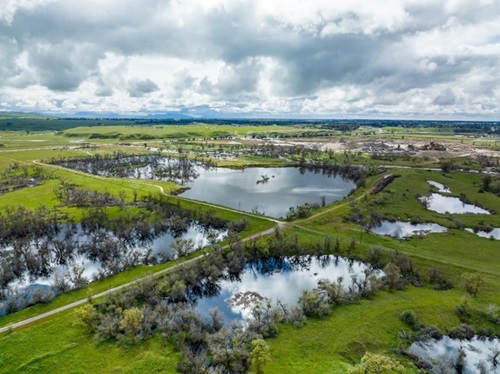Groundwater Recharge

View from a drone of a groundwater recharge project at Ball Ranch near San Joaquin River in Fresno County, California. Photo taken by the Department of Water Resources March 30, 2023.
Groundwater recharge is a key strategy throughout California to manage water through climate-driven weather extremes, including prolonged drought and periodic intense storm events, as identified in the Newsom Administration’s California’s Water Supply Strategy: Adapting to a Hotter, Drier Future.
During drier years, when there is less snowpack and precipitation, groundwater accounts for up to 60 percent of the State’s total water supply.
During wet years, groundwater recharge – where water moves down (infiltrates) from the ground surface or the bottom of a waterway into an underlying aquifer – helps balance and replenish groundwater basins for use during future dry and drought years. California’s groundwater basins can hold a massive amount of water – at least 850 million acre-feet, compared to the 50 million acre-feet that all the major above-ground reservoirs can hold combined.
Groundwater Recharge in California – A Key Water Resilience Strategy
Video also available in the following languages:
More information on groundwater and recharge can be found on https://water.ca.gov/Water-Basics/Groundwater.
Recent Groundwater Recharge Projects
Rip and Chip Program at Consolidated Irrigation District
Links to other project videos
- Sacramento Regional Water Bank
- Omochumne Hartnell Water District
- James Irrigation District
- Consolidated Irrigation District
- Fresno Irrigation District
- City of Roseville Aquifer Storage and Recovery
- Terranova Ranch
- Dunnigan Area Recharge Projects
Actions to Expedite Flood Diversion and Recharge
The State is taking strong and coordinated steps to expedite and track groundwater recharge initiatives. These actions help mitigate impacts from ongoing reliance on groundwater during drought years and support local agencies who are striving towards long-term groundwater sustainability under the Sustainable Groundwater Management Act (SGMA).
Temporary Flood Diversion Equipment & Recharge Enhancement
In April 2023, DWR secured one-time emergency funding and launched the Temporary Flood Diversion Equipment and Recharge Enhancement emergency effort, to help local agencies in the Tulare Lake region maximize flood diversions and reduce flood risk from high flow conditions, with an incidental benefit of groundwater recharge.
DWR actively worked with local agencies and equipment vendors to secure temporary flood diversion equipment – pumps and siphons – that can divert high flows off of rivers and move them to recharge areas managed by local agencies. The temporary flood diversion equipment provided through DWR’s support helps reduce flood risk and benefit communities that rely on groundwater wells in shallow aquifers by recharging the groundwater basins. Funding was also provided for the clearing of agricultural lands (“Rip & Chip”) to support development of permanent groundwater recharge basins and increase local capacity to receive future flood flows onto these lands.
Flood Diversion and Recharge Enhancement (FDRE) Initiative
Building on the success of the 2023 emergency effort, DWR secured additional one-time funding and launched the Flood Diversion and Recharge Enhancement (FDRE) Initiative in December 2023. With increased funding DWR has been able to support more local agencies, expand the types of actions covered, and provide assistance over multiple winter seasons. FDRE emergency contracts were executed in June 2024 and will provide flood diversion and recharge benefits at least through June 2026. Project activities include temporary pump rentals and purchases, protective screen design and purchase, land clearing, temporary flood basin development, and temporary conveyance improvements. Additional information about this initiative can be found in the FDRE Brochure.
Funding for FDRE has been exhausted, but please fill out this FDRE Future Interest Form to express interest in this type of assistance if future funding becomes available. For questions, please email recharge@water.ca.gov.
Executive Order Flood Diversions for Recharge
Governor Newsom issued multiple executive orders (N-4-23 and N-7-23) in 2023 to respond to the Tulare Lake flooding emergency that allowed for the diversion of flood flows for recharge without a water right. All diversions were required to be reported to the State Water Resources Control Board and information regarding these diversions can be found here.
Senate Bill 122 of 2023: Codifying Executive Order Language
Section 25 of Senate Bill 122 (2023) modified California Water Code Section 1242.1, enacting some of the Executive Order language. SB 122 sets a sunset date of January 1, 2029. Additional information and reported diversions under Water Code Section 1242.1 can be found here.
The State Water Resources Control Board held a workshop for an overview of diversions under 1242.1 on October 9, 2024. This workshop has been recorded and posted to YouTube here.
